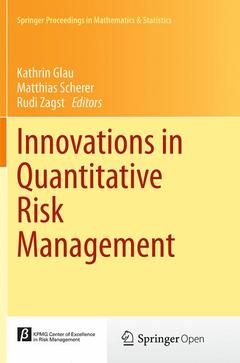Description
Innovations in Quantitative Risk Management, Softcover reprint of the original 1st ed. 2015
TU München, September 2013
Springer Proceedings in Mathematics & Statistics Series, Vol. 99
Language: English
Subjects for Innovations in Quantitative Risk Management:
Publication date: 09-2016
Support: Print on demand
Publication date: 01-2015
438 p. · 15.5x23.5 cm · Hardback
Description
/li>Contents
/li>Biography
/li>Comment
/li>
Quantitative models are omnipresent ?but often controversially discussed? in todays risk management practice. New regulations, innovative ?nancial products, and advances in valuation techniques provide a continuous ?ow of challenging problems for ?nancial engineers and risk managers alike. Designing a sound stochastic model requires ?nding a careful balance between parsimonious model assumptions, mathematical viability, and interpretability of the output. Moreover, data requirements and the end-user training are to be considered as well.
The KPMG Center of Excellence in Risk Management conference Risk Management Reloaded and this proceedings volume contribute to bridging the gap between academia ?providing methodological advances? and practice ?having a ?rm understanding of the economic conditions in which a given model is used. Discussed ?elds of application range from asset management, credit risk, and energy to risk management issues in insurance. Methodologically, dependence modeling, multiple-curve interest rate-models, and model risk are addressed. Finally, regulatory developments and possible limits of mathematical modeling are discussed.
Kathrin Glau is Junior professor for Mathematical Finance at the Technische Universität München. Her research faces the complex demands on numerical tools and modeling in today’s market reality. Her approach merges recent advances from numerical analysis and financial modeling. Thereby pricing methods in advanced models with a thorough error analysis are developed. Her speciality are Galerkin methods for partial integro differential equations for (pure) jump Levy driven models.
Matthias Scherer is Professor for Mathematical Finance at the Technische Universität München. His research interests comprise various topics in Financial Mathematics, Actuarial Science, and Probability Theory. Concerning applications in risk management, he has published research articles on portfolio-credit risk, dependence modeling, and model risk. He is an active member of the management boards of the DGVFM and the KPMG Center of Excellence in Risk Management. He is co-author of the book “Simulating Copulas: Stochastic Models, Sampling Algorithms, and Applications” and provides executive seminars for different financial institutions.
Rudi Zagst is Professor for Mathematical Finance, Director of the Center of Mathematics and member of the management board of the KPMG Center of Excellence in Risk Management at Technische Universität München. He is also President of risklab GmbH, a German-based consulting company offering advanced asset management solutions and is a professional trainer to a number of leading institutions. His current research interests are in financial engineering, risk and asset management.




